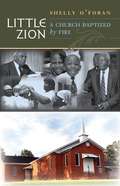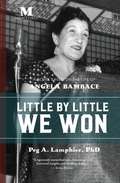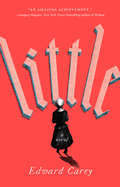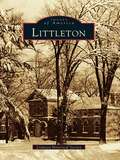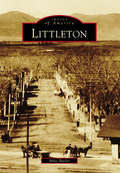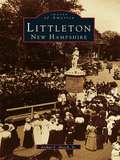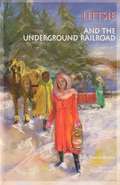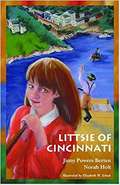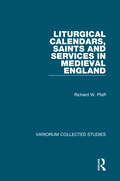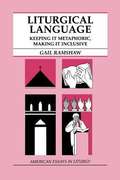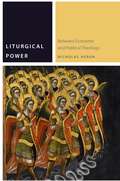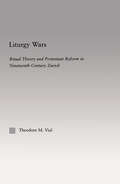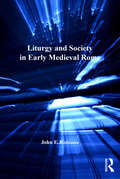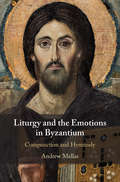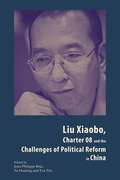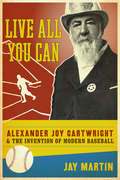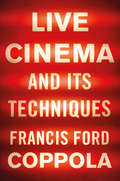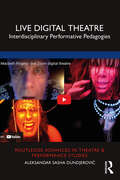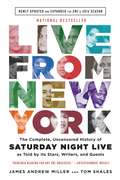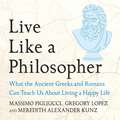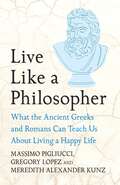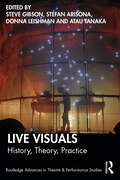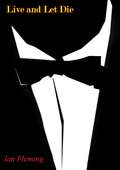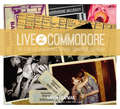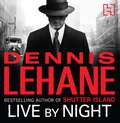- Table View
- List View
Little Zion
by Shelly O'ForanThe arson attacks in early 2006 on a number of small Baptist churches in rural Alabama recalled the rash of burnings at dozens of predominantly black houses of worship in the South during the mid-1990s. One of the churches struck by probable arson in 1996 was Little Zion Baptist Church in Boligee, Alabama. This book draws on the voices and memories of church members to share a previously undocumented history of Little Zion, from its beginnings as a brush arbor around the time of emancipation, to its key role in the civil rights movement, to its burning and rebuilding with the help of volunteers from around the world.Folklorist Shelly O'Foran, a Quaker who went to Boligee as a volunteer in the church rebuilding effort, describes Little Zion as always having been much more than the building itself. She shows how the spiritual and social traditions that the residents of Boligee practice and teach their children have assured the continued vitality of the church and community. Through thoughtful fieldwork and presentation, Little Zion also explores the power of oral narrative to promote understanding between those inside and outside the church community. Illustrated with historical and contemporary photographs, this volume is both a celebration of Little Zion's history and an invitation to share in its long life story.
Little by Little We Won: A Novel Based on the Life of Angela Bambace
by Peg A. LamphierWomen marched for equal pay, the President of the United States advocated an anti-immigration policy, and the income gap between the rich and poor continued to grow. And it was just the beginning of the 20th century. As a girl growing up in Italian Harlem, Angela Bambace needed answers. How could it be acceptable for women not to earn equal pay for equal work? Why were immigrants relegated to the factory jobs no one else would take and working under such dangerous and inhumane conditions? And why were the businessmen at the top getting richer and richer while the poor who worked for them struggled to provide for their own families? How could any of this be okay? But perhaps Angela's most consequential question was If not me, then who? Born to a father and married to a man who both believed a woman's place was in the home, Angela Bambace defied her family and social expectations to lead a labor union--organizing women's marches, strikes, and protests "to build a better world, a better place for everybody." Today, Angela's story might be more significant than ever as others continue her fight and call to action.
Little: A Novel
by Edward Carey"An amazing achievement...A compulsively readable novel, so canny and weird and surfeited with the reality of human capacity and ingenuity that I am stymied for comparison. Dickens and David Lynch? Defoe meets Margaret Atwood? Judge for yourself." --Gregory Maguire, New York Times bestselling author of WickedThe wry, macabre, unforgettable tale of an ambitious orphan in Revolutionary Paris, befriended by royalty and radicals, who transforms herself into the legendary Madame Tussaud. In 1761, a tiny, odd-looking girl named Marie is born in a village in Switzerland. After the death of her parents, she is apprenticed to an eccentric wax sculptor and whisked off to the seamy streets of Paris, where they meet a domineering widow and her quiet, pale son. Together, they convert an abandoned monkey house into an exhibition hall for wax heads, and the spectacle becomes a sensation. As word of her artistic talent spreads, Marie is called to Versailles, where she tutors a princess and saves Marie Antoinette in childbirth. But outside the palace walls, Paris is roiling: The revolutionary mob is demanding heads, and . . . at the wax museum, heads are what they do.In the tradition of Gregory Maguire's Wicked and Erin Morgenstern's The Night Circus, Edward Carey's Little is a darkly endearing cavalcade of a novel--a story of art, class, determination, and how we hold on to what we love.
Littleton
by Littleton Historical SocietyIncorporated in 1714, Littleton began as a typical New England farming town. While it enjoyed modest growth through the early years, it was not until after World War II that the population began its steady climb. Two major highways, Route 2 in the 1950s and Interstate 495 in the 1960s, cut through the town, and Littleton became an attractive bedroom community with convenient access to the expanding technological industry of Massachusetts. The population rose from 1,447 in 1930 to approximately 6,300 in 1970, and industry began to overtake the dairy farms and apple orchards. Still, the impression of a rural setting, the open space, and an intangible quality of life contribute to the small-town character for which Littleton is celebrated.Through vintage photographs, many never before published, Littleton connects the current generations with the town's past. Vintage photographs of homes that have changed in appearance or have been destroyed for expansion recall a time of farmhouses and open fields. The book also follows the growth of Littleton, including the emergence of the Conant-Houghton Company and the depot area, as well as the Long Lake and Lake Warren resorts.
Littleton
by Mike ButlerIn 1858, gold was discovered where Little Dry Creek joins the South Platte River, four miles north of what is today Littleton. After the initial rush of gold-seekers, agriculture sustained growth when the gold deposits played out. In 1861, Richard S. Little filed claims for agricultural land along the South Platte River in what would become Littleton. Little was not only a farmer but a land developer, and he filed his plat at the Arapahoe County Courthouse in 1872 for streets and homes on his property. When the Denver & Rio Grande Railroad built south from Denver through Littleton in 1871, development soon followed, and Little had no shortage of buyers for his plots of land. Thus began Littleton, and over the years of boom and bust, this early settlement has transitioned from village to county seat to one of Denver's finest suburbs.
Littleton, New Hampshire (Images of America)
by Arthur F. March Jr.Littleton, New Hampshire, is listed number eleven in Norman Crampton's One Hundred Best Small Towns in America, and it does indeed have a great deal to offer. Situated between two major rivers in the heart of the White Mountains, it was incorporated in 1784 but it wasn't until the nineteenth century that the incredibly striking natural beauty of the surrounding area was discovered by the outside world.With the development of photography in the mid-nineteenth century the grandeur of Littleton's mountain scenery soon began to attract photographers to the area, and their images of the mirror-like lakes, winding rivers, dense, dark forests, and craggy mountains began a tourist boom that continues to this day.
Littsie And The Underground Railroad
by Schott ElizabethLittsie O'Donnell, orphaned by the cholera epidemic of 1832, tells the story of struggling to raise her little sister and of her involvement in the Underground Railroad. Her friendship with a former slave is deepened as they both discover the meaning of freedom. The story brings to life abolitionists such as Harriet Beecher Stowe, James Birney and Theodore Weld. Aided in their adventures by a former cicrcus horse, Dan, they grow up learning that freedom does not come easily; it requires courage and commitment.
Littsie of Cincinnati
by Jinny Powers Berten Norah HoltLittsie of Cincinnati tells the story of Littsie O'Donnell, daughter of Irish immigrants, who grew up in colorful, dynamic, early Cincinnati. When the cholera epidemic of 1832 devastates her family, she responds to the tragedy with bravery and determination. Littsie's story involving pioneer life, steamboats, slavery, cholera and separated sisters is one of high adventure and persistent courageous love.
Liturgical Calendars, Saints and Services in Medieval England (Variorum Collected Studies)
by Richard W. PfaffThis book includes four hitherto unpublished papers together with a substantial introductory historiographical and bibliographical overview. Many of the studies concern the liturgical views of figures like Lanfranc, St Hugh of Lincoln, and William of Malmesbury (an edition of William’s Abbreviatio Amalarii is included) and the ways Thomas Becket and the Venerable Bede were viewed liturgically. Others reveal the achievement of an 11th-century Canterbury scribe, lay out a hagiographical puzzle as to the saints venerated on the 19th January, ask why calendars come to be attached to psalters, demonstrate that monks at Canterbury Cathedral were still reading Old English homilies in the 1180s, and present a fascinating, previously misunderstood, psalter owned by bishop Ralph Baldock, c.1300. Two final papers deal with ’Sarum’ services in late medieval parish churches and with the devotional practice called St Gregory’s Trental.
Liturgical Language: Keeping It Metaphoric, Making It Inclusive
by Gail RamshawThrough a review of the history of language, Ramshaw illustrates the difficulties of forming texts from words that have undergone numerous translations and whose primary meanings have also changed throughout the centuries. Her discussion of symbolic imagery and theological language illustrates how essential it is that words be evaluated and chosen with understanding and care.
Liturgical Power: Between Economic and Political Theology (Commonalities)
by Nicholas HeronIs Christianity exclusively a religious phenomenon, which must separate itself from all things political, or do its concepts actually underpin secular politics? To this question, which animated the twentieth-century debate on political theology, Liturgical Power advances a third alternative. Christian anti-politics, Heron contends, entails its own distinct conception of politics. Yet this politics, he argues, assumes the form of what today we call “administration,” but which the ancients termed “economics.” The book’s principal aim is thus genealogical: it seeks to understand our current conception of government in light of an important but rarely acknowledged transformation in the idea of politics brought about by Christianity.This transformation in the idea of politics precipitates in turn a concurrent shift in the organization of power; an organization whose determining principle, Heron contends, is liturgy—understood in the broad sense as “public service.” Whereas until now only liturgy’s acclamatory dimension has made the concept available for political theory, Heron positions it more broadly as a technique of governance. What Christianity has bequeathed to political thought and forms, he argues, is thus a paradoxical technology of power that is grounded uniquely in service.
Liturgy Wars: Ritual Theory and Protestant Reform in Nineteenth-Century Zurich (Religion in History, Society and Culture #Vol. 4)
by Theodore M. VialThe nineteenth century was a period of intense religious conflict across Europe, as people confronted the major changes brought by modernity. In Zurich, one phase of this religious conflict was played out in a struggle over revisions to the ritual of baptism. In its analysis of the Zurich conflict, Liturgy Wars offers a strategy for understanding the links between theology, ritual, and socio-politics. Theodore M. Vial offers a new perspective on contemporary ritual studies - and critiques the cognivist approaches of Lawson and McCauley, as well as Catherine Bell's analysis of power and the body - by reintergrating the imporatance of speech acts into considerations of ritual.
Liturgy and Society in Early Medieval Rome (Church, Faith and Culture in the Medieval West)
by John F. RomanoThe liturgy, the public worship of the Catholic Church, was a crucial factor in forging the society of early medieval Rome. As the Roman Empire dissolved, a new world emerged as Christian bishops stepped into the power vacuum left by the dismantling of the Empire. Among these potentates, none was more important than the bishop of Rome, the pope. The documents, archaeology, and architecture that issued forth from papal Rome in the seventh and eighth centuries preserve a precious glimpse into novel societal patterns. The underexploited liturgical sources in particular enrich and complicate our historical understanding of this period. They show how liturgy was the ’social glue’ that held together the Christian society of early medieval Rome - and excluded those who did not belong to it. This study places the liturgy center stage, filling a gap in research on early medieval Rome and demonstrating the utility of investigating how the liturgy functioned in medieval Europe. It includes a detailed analysis of the papal Mass, the central act of liturgy and the most obvious example of the close interaction of liturgy, social relations and power. The first extant Mass liturgy, the First Roman Ordo, is also given a new presentation in Latin here with an English translation and commentary. Other grand liturgical events such as penitential processions are also examined, as well as more mundane acts of worship. Far from a pious business with limited influence, the liturgy established an exchange between humans and the divine that oriented Roman society to God and fostered the dominance of the clergy.
Liturgy and the Emotions in Byzantium: Compunction and Hymnody
by Andrew MellasThis book explores the liturgical experience of emotions in Byzantium through the hymns of Romanos the Melodist, Andrew of Crete and Kassia. It reimagines the performance of their hymns during Great Lent and Holy Week in Constantinople. In doing so, it understands compunction as a liturgical emotion, intertwined with paradisal nostalgia, a desire for repentance and a wellspring of tears. For the faithful, liturgical emotions were embodied experiences that were enacted through sacred song and mystagogy. The three hymnographers chosen for this study span a period of nearly four centuries and had an important connection to Constantinople, which forms the topographical and liturgical nexus of the study. Their work also covers three distinct genres of hymnography: kontakion, kanon and sticheron idiomelon. Through these lenses of period, place and genre this study examines the affective performativity hymns and the Byzantine experience of compunction.
Liu Xiaobo, Charter 08 and the Challenges of Political Reform in China
by Jean-Philippe BejaIn December 2008 some 350 Chinese intellectuals published a manifesto calling for reform of the Chinese constitution and an end to one-party rule. Known as 'Charter 08,' the manifesto has since been signed by more than 10,000 people. One of its authors, Liu Xiaobo, was awarded the Nobel Peace Prize in 2010 but has remained in prison since 2009 for subversive crimes. This collection of essays - the first of its kind in English - examines the trial of Liu Xiaobo, the significance and impact of Charter 08, and the prospects for reform in China. The essays include contributions from legal and political experts from around the world, an account of Liu's trial by his defence lawyers, and a passionate - and ultimately optimistic - account of resistance, repression and political change by the human rights lawyer Teng Biao.
Live All You Can: Alexander Joy Cartwright and the Invention of Modern Baseball
by Jay MartinLaying waste to the notion that Abner Doubleday established the modern game of baseball, acclaimed biographer Jay Martin makes a bold case for A. J. Cartwright (1820-1892), an entrepreneur, philanthropist, and avid ballplayer whose keen perception and restless spirit codified the rules of the sport and engineered its rapid spread throughout the country.Consulting Cartwright's personal correspondence and papers, Martin shows how this American archetype synthesized a number of elements from popular ballgames into the program, bylaws, and positions we find on the field today. After formalizing his blueprint, Cartwright worked tirelessly to promote baseball nationwide, appealing to both upper- and lower-class spectators and ballplayers and weaving a trail of influence across nineteenth-century America. Addressing the controversy that has roiled for years around the claims for Doubleday and Cartwright, Martin revisits the original arguments behind each camp and throws into sharp relief the competing ambitions of these figures during a time of aggressive westward expansion and unparalleled opportunities for individual reinvention. Martin's story of modern baseball not only offers a fascinating window into a thoroughly American phenomenon but also accesses a rare history of American ideals.
Live Cinema and Its Techniques
by Francis Ford CoppolaFrom a master of cinema comes this “gold mine of a book . . . a rocket ride to the potential future” of filmmaking (Walter Murch). Celebrated as an “exhilarating account” of a revolutionary new medium (Booklist), Francis Ford Coppola’s indispensable guide to live cinema is a boon for moviegoers, film students, and teachers alike. As digital movie-making, like live sports, can now be performed by one director—or by a collaborative team online— it is only a matter of time before cinema auteurs will create “live” movies to be broadcast instantly in faraway theaters. “Peppered with brilliant personal observations” (Wendy Doniger), Live Cinema and Its Techniques offers a behind-the-scenes look at a consummate career: from Coppola’s formative boyhood obsession with live 1950s television shows and later attempts to imitate the spontaneity of live performance on set, the book usefully includes a guide to presenting state-of-the-art techniques on everything from rehearsals to equipment. A testament to Coppola’s prodigious enthusiasm for reinvigorating the form, Live Cinema is an indispensable guide that “reenergizes . . . the search for a new way of storytelling” (William Friedkin).
Live Digital Theatre: Interdisciplinary Performative Pedagogies (Routledge Advances in Theatre & Performance Studies)
by Aleksandar Sasha DundjerovićLive Digital Theatre explores the experiences of Interdisciplinary Performing Arts practitioners working on digital performance and in particular live digital theatre. Collaborating with world-leading practitioners – Kolectiv Theatre (UK), Teatro Os Satyros (Brazil), and The Red Curtain International (India)- this study investigates the ways to bring live digital performance into theatre training and performance making. The idea of Interdisciplinary Performative Pedagogies is placed within the context of the exploration of live digital theatre and is used to understand creative practices and how one can learn from these practices. The book presents a pedagogical approach to contemporary practices in digital performance; from interdisciplinary live performance using digital technology, to live Zoom theatre, YouTube, mixed media recorded and live performance. The book also combines a series of case studies and pedagogical practices on live digital performance and intermedial theatre. This book will be of great interest to students and scholars in performing arts, digital arts, media, and gaming.
Live From New York: The Complete, Uncensored History of Saturday Night Live as Told by Its Stars, Writers, and Guests
by James Andrew Miller Tom ShalesJust in time for the 40th anniversary of Saturday Night Live, a rollickingly updated edition of LIVE FROM NEW YORK with nearly 100 new pages covering the past decade.When first published to celebrate the 30th anniversary of Saturday Night Live, LIVE FROM NEW YORK was immediately proclaimed the best book ever produced on the landmark and legendary late-night show. In their own words, unfiltered and uncensored, a dazzling galaxy of trail-blazing talents recalled three turbulent decades of on-camera antics and off-camera escapades. Now a fourth decade has passed---and bestselling authors James Andrew Miller and Tom Shales have returned to Studio 8H. Over more than 100 pages of new material, they raucously and revealingly take the SNL story up to the present, adding a constellation of iconic new stars, surprises, and controversies.
Live Like A Philosopher: What the Ancient Greeks and Romans Can Teach Us About Living a Happy Life
by Massimo Pigliucci Gregory Lopez Meredith Alexander KunzA wide-ranging philosophical and practical guide to incorporating the wisdom of ancient philosophers into daily modern life.What does life truly mean? Who do I want to become? And how do I get there? These are some of life's biggest questions that can be hard to think through. Fortunately, a group of philosophers from ancient Greece and Rome have already done a lot of the heavy lifting. Drawing on the philosophies, life lessons and experiences of key thinkers, Live Like a Philosopher will help you navigate these existential waters with invaluable insights for modern life.From finding balance with Aristotle and embracing uncertainty with Cicero to avoiding pain with Epicurus and learning how to rebel with Cynic Hipparchia, this is a powerful toolkit to help you navigate the highs and lows of modern life. Organized around three main themes of pleasure, virtue, and doubt, there's something to learn from each master in this philosophical quest. Live Like a Philosopher is the helping hand we all need to make life better.
Live Like A Philosopher: What the Ancient Greeks and Romans Can Teach Us About Living a Happy Life
by Massimo Pigliucci Gregory Lopez Meredith Alexander KunzA wide-ranging philosophical and practical guide to incorporating the wisdom of ancient philosophers into daily modern life.What does life truly mean? Who do I want to become? And how do I get there? These are some of life's biggest questions that can be hard to think through. Fortunately, a group of philosophers from ancient Greece and Rome have already done a lot of the heavy lifting. Drawing on the philosophies, life lessons and experiences of key thinkers, Live Like a Philosopher will help you navigate these existential waters with invaluable insights for modern life.From finding balance with Aristotle and embracing uncertainty with Cicero to avoiding pain with Epicurus and learning how to rebel with Cynic Hipparchia, this is a powerful toolkit to help you navigate the highs and lows of modern life. Organized around three main themes of pleasure, virtue, and doubt, there's something to learn from each master in this philosophical quest. Live Like a Philosopher is the helping hand we all need to make life better.
Live Visuals: History, Theory, Practice (Routledge Advances in Theatre & Performance Studies)
by Steve Gibson Stefan Arisona Donna Leishman Atau TanakaThis volume surveys the key histories, theories and practice of artists, musicians, filmmakers, designers, architects and technologists that have worked and continue to work with visual material in real time. Covering a wide historical period from Pythagoras’s mathematics of music and colour in ancient Greece, to Castel’s ocular harpsichord in the 18th century, to the visual music of the mid-20th century, to the liquid light shows of the 1960s and finally to the virtual reality and projection mapping of the present moment, Live Visuals is both an overarching history of real-time visuals and audio-visual art and a crucial source for understanding the various theories about audio-visual synchronization. With the inclusion of an overview of various forms of contemporary practice in Live Visuals culture – from VJing to immersive environments, architecture to design – Live Visuals also presents the key ideas of practitioners who work with the visual in a live context. This book will appeal to a wide range of scholars, students, artists, designers and enthusiasts. It will particularly interest VJs, DJs, electronic musicians, filmmakers, interaction designers and technologists.
Live and Let Die: James Bond 007 (Macmillan Readers Ser. #2)
by Ian FlemingWhen 007 goes to Harlem, it’s not just for the jazz. For Harlem is the kingdom of Mr Big, black master of crime, voodoo baron, senior partner in SMERSH’s grim company of death.Those he cannot possess, he crushes;those who cross him will meet painful ends.Like his beautiful prisoner, Solitaire.And her lover, James Bond.Both are marked out as victims in a trail of terror, treachery and torture that leads from New York’s black underworld to the shark-infested island in the sun that Mr Bier calls his own…‘Speed…tremendous zest communicated excitement. Brrh! How wincingly well Mr Fleming writes ‘—JULIAN SYMONS, SUNDAY TIMES
Live at the Commodore
by Aaron ChapmanVancouver's Commodore Ballroom is, like New York's CBGB's and Los Angeles's Whiskey a Go-Go, one of the most venerated rock clubs in the world; originally built in 1930, it's hosted a who's-who of music greats before they made it big: The Police, The Clash, Blondie, Talking Heads, Nirvana, New York Dolls, U2, and, more recently, Lady Gaga and the White Stripes. Filled with never-before-published photographs, posters, and paraphernalia, Live at the Commodore is a visceral, energetic portrait of one of the world's great rock venues.Aaron Chapman is a musician and journalist, and the author of Liquor, Lust, and the Law.
Live by Night
by Dennis LehaneJoe Coughlin is nineteen when he meets Emma Gould. A smalltime thief in 1920s Boston, he is told to cuff her while his accomplices raid the casino she works for. But Joe falls in love with Emma - and his life changes for ever.That meeting is the beginning of Joe's journey to becoming one of the nation's most feared and respected gangsters. It is a journey beset by violence, double-crossing, drama and pain. And it is a journey into the soul of prohibition-era America...A powerful, deeply moving novel, Live By Night is a tour-de-force by Dennis Lehane, writer on The Wire and author of modern classics such as Shutter Island, Gone, Baby, Gone and The Given Day.
